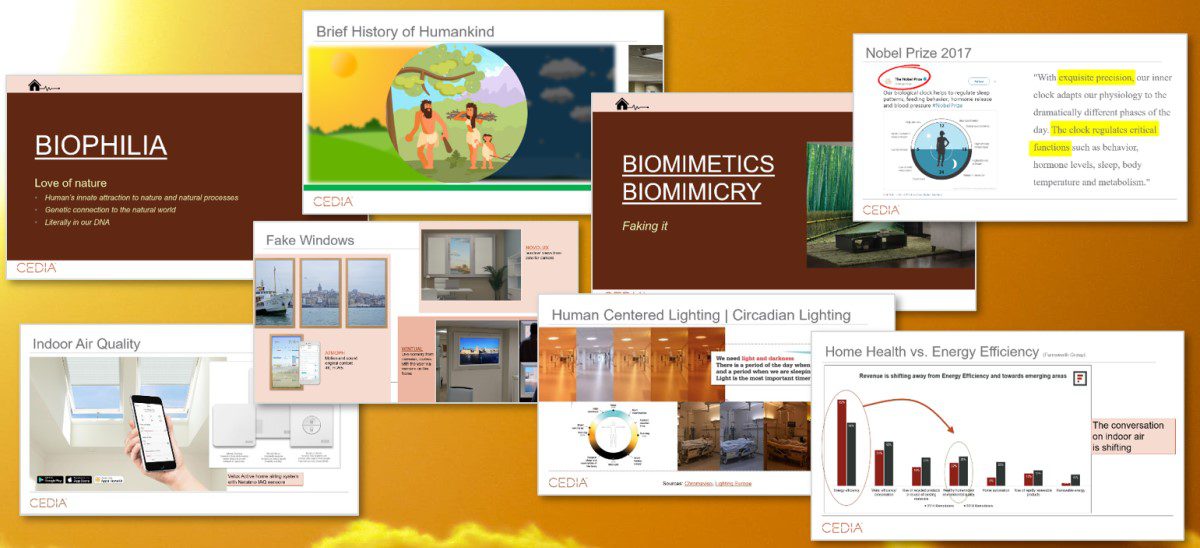Biophilia, Wellness, and Smart Homes
Humans are hardwired to relish nature and thrive in a 24-hour circadian cycle. Smart-home pros can fake-believe nature through smart lighting, indoor air quality, beneficial sounds, visuals and other wellness-related stimuli.

Biophilia. This one word changes my entire outlook on smart-home technology and the pros who install it – all for the better.
Literally meaning the love of living things, biophilia refers to our biological attachment to nature. Our closest ancestors lived outdoors for a few hundred-thousand years, so it’s no surprise nature is hard-coded in our DNA. We evolved to thrive in ecosystems of 24-hour day/night cycles with predictable lighting and weather patterns and all the sounds, smells, and sights of nature.
What happens, then, when we rather abruptly (in humankind years) retreat from the forests, streams, sunshine and chirping birds, and hole ourselves up in homes, offices, schools and malls for 90 percent of the time – which is what we do today? Our minds and bodies get confused — and sick — because we weren’t built for that kind of living.
Whether we know it or not, we physically crave the sounds, smells and visuals of the great outdoors. And we long for the all-important natural cues – lighting and air conditions especially – that synch with our deeply ingrained 24-hour circadian clocks.
It makes sense, to be sure, but now a growing body of “well building” research tells us just how dangerous our nature-deprivation can be, contributing to everything from fatigue and hypertension to depression, diabetes, heart disease and cancer.
The good news is that nature can be faked pretty effectively, providing wellness benefits in “built” environments akin to those produced outdoors – a practice known as biomimicry or biomimetics. The home-technology sector is already doing it. If you’re automating tunable white lights to simulate the intensity and color temperature of natural daylight, then congrats! You are a biomimic.
So Much More than Circadian Lighting
So-called circadian lighting, however, is just the beginning. We can reinforce the connection to nature by adding context – like a tree, or an image of a tree – which multiplies the benefits of daylighting alone.
One case study, for example, looked at a California call center, where all employees enjoyed optimal daylight conditions, but no clear views of the outdoors. At one point, desks were repositioned such that workers could see trees in their peripheral vision, resulting in a 6- to 12-percent gain in call-handling efficiencies.
Additional research indicates faster recovery rates and less pain among hospital patients with a view of green space versus a brick wall. And the science keeps coming.
Of course, not every work or living space can have a window, let alone a decent view. Here again, home-tech pros could employ biomimetics to simulate a view of nature. There is evidence that virtual windows (and skylights) can have a beneficial effect on wellness … if done realistically.
Don’t just slap a TV on a wall, and then stream nature scenes through it (although just that could be beneficial, studies show). Context is everything. “The trick is not in replicating content, but in staging it within the proper environmental or architectural setting,” say the authors of a 2016 report on “Simulated Nature.”
Home-tech integrators work with carpenters and other design/build trades all the time to incorporate TVs into furniture and other room elements. Creating a believable virtual window should be a relatively simple project with potentially major returns.
We’re not done yet. Like lighting and visual stimuli, sound can also play an important role in connecting us with nature and influencing our wellness.
In at least one study, participants who listened to river sounds after completing a stressful task reported having more energy and greater motivation after a “restoration” period compared to those who only listened to office noise or silence. What was even more effective than the river sounds alone? Pairing the audio with a nature video, of course!
Research on auditory stimuli and wellness is fairly plentiful, with different types of sounds shown to improve (or diminish) concentration, happiness, calmness, productivity, sleep and other outcomes. Music therapy is being used to reduce recidivism among former inmates, improve end-of-life palliative care, and even calm dogs in kennels (pooches, by the way, might prefer reggae and audiobooks).
Get ready for wellness! The anecdotes discussed here barely scratch the surface of this great opportunity. We hardly mentioned indoor air quality, let alone prospects for aromatherapy, AR, VR and so many other elements that can make or break a wellness experience.
Source: CEPro
Author: Julie Jacobson